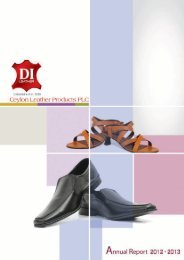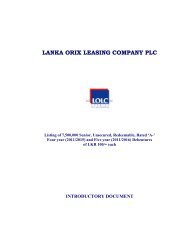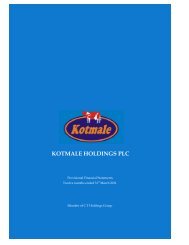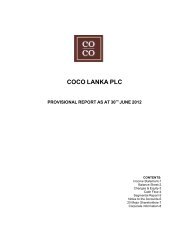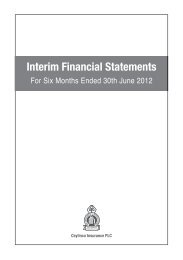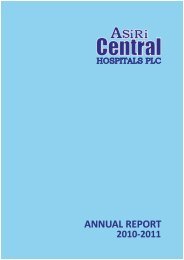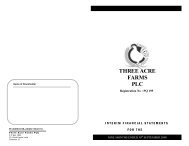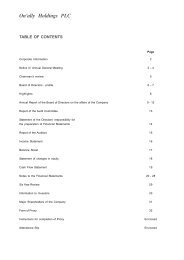Annual Report 2009/10 - Colombo Stock Exchange
Annual Report 2009/10 - Colombo Stock Exchange
Annual Report 2009/10 - Colombo Stock Exchange
You also want an ePaper? Increase the reach of your titles
YUMPU automatically turns print PDFs into web optimized ePapers that Google loves.
Connecting Sri Lanka to Progress<br />
Sierra Cables PLC - <strong>Annual</strong> <strong>Report</strong> <strong>2009</strong>/<strong>10</strong><br />
23<br />
Significant Accounting Policies<br />
3. FOREIGN CURRENCY TRANSLATION<br />
Foreign Currency Transactions<br />
The Company Financial Statements are presented in<br />
Sri Lanka Rupees, which is the Company’s functional and<br />
presentation currency.<br />
All foreign exchange transactions are converted to Sri Lanka<br />
Rupees, at the rates of exchange prevailing at the time the<br />
transactions are effected.<br />
Monetary assets and liabilities denominated in foreign currency are<br />
retranslated to Sri Lanka Rupee equivalents at the exchange rate<br />
prevailing at the Balance Sheet date. Non-monetary assets and<br />
liabilities are translated using exchange rates that existed when<br />
the values were determined. The resulting gains and losses are<br />
accounted for in the Income Statement.<br />
4. INCOME TAX EXPENSES<br />
Income tax expense comprises current and deferred tax. Income<br />
tax expense is recognized in profit or loss except to the extent that<br />
it relates to items recognized directly in equity, in which case it is<br />
recognized in equity.<br />
Current Tax<br />
Current tax is the expected tax payable on the taxable income<br />
for the year, using tax rates enacted or substantively enacted at<br />
the reporting date, and any adjustment to tax payable in respect<br />
of previous years. The elements of income and expenditure<br />
as reported in the Financial Statements and computed<br />
in accordance with the provisions of the Inland Revenue<br />
Act No. <strong>10</strong> of 2006 and amendments thereto. Relevant details are<br />
disclosed in Note 5 to the Financial Statements.<br />
Deferred Tax<br />
Deferred tax is provided using the liability method on temporary<br />
differences at the Balance Sheet date between the tax bases<br />
of assets and liabilities, and their carrying amounts for financial<br />
reporting purposes.<br />
Deferred tax assets and liabilities are recognised for all<br />
temporary differences. Deferred tax assets are recognised for<br />
all deductible temporary differences, carry-forward of unused<br />
tax credits and unused tax losses, to the extent that it is probable<br />
that taxable profit will be available against which the deductible<br />
temporary differences, and the carry-forward of unused tax<br />
credits and unused tax losses can be utilized.<br />
The carrying amount of deferred tax assets is reviewed at each<br />
Balance Sheet date and reduced to the extent that it is no longer<br />
probable that sufficient taxable profit will be available to allow<br />
all or part of the deferred tax asset to be utilised. Unrecognised<br />
deferred tax assets are reassessed at each Balance Sheet date<br />
and are recognised to the extent that it has become probable<br />
that future taxable profit will allow the deferred tax asset to be<br />
recovered.<br />
Deferred tax assets and liabilities are measured at tax rates that<br />
are expected to apply to the year when the asset is realised or<br />
liability is settled, based on the tax rates and tax laws that have<br />
been enacted or substantively enacted as at the Balance Sheet<br />
date.<br />
Income tax relating to items recognised directly in equity is<br />
recognised in equity.<br />
Deferred tax assets and deferred tax liabilities are offset, if a<br />
legally enforceable right exists to set off current tax assets against<br />
current tax liabilities and the deferred taxes relate to the same<br />
taxable entity and the same taxation authority.<br />
5. VALUATION OF ASSETS AND THEIR BASES OF<br />
MEASUREMENT<br />
Property, Plant & Equipment<br />
- Recognition and Measurement<br />
The property, plant & equipment are recorded at cost less accumulated<br />
depreciation and impairment losses as setout below.<br />
Items of property, plant and equipment are derecognised upon<br />
disposal or when no future economic benefits are expected from<br />
its use. Any gain or loss arising on derecognition of the asset<br />
is included in the Income Statement in the year the asset is<br />
derecognised.<br />
The cost of property, plant & equipment is the cost of purchase or<br />
construction together with any expenses incurred in bringing the<br />
assets to its working condition for its intended use.<br />
Expenditure incurred for the purpose of acquiring, extending<br />
or improving assets of permanent nature by means of which to<br />
carry on the businesses or to increase the earning capacity of the<br />
business has been treated as capital expenditure.<br />
The cost of property, plant & equipment is the cash price equivalent<br />
at the recognition date. If payment is deferred beyond normal credit<br />
terms, the difference between the cash price equivalent and the<br />
total payment is recognized as interest over the period of credit<br />
unless such interest is recognized in the carrying amount of the<br />
item in accordance with the allowed alternative treatment in SLAS<br />
20 “Borrowing Costs”.<br />
The carrying values of property, plant & equipment are reviewed<br />
for impairment when events or changes in circumstances indicate<br />
that the carrying value may not be recoverable.<br />
- Subsequent Costs/ Replacement of Parts<br />
The cost of replacing part of an item of property, plant & equipment<br />
is recognized in the carrying amount of the item if it is probable<br />
that the future economic benefits embodied within the part will<br />
flow to the Company and its cost can be measured reliably. The<br />
carrying amount of those parts that are replaced is derecognized.<br />
The costs of the day-to-day servicing of property, plant and<br />
equipment are recognized in profit or loss as incurred.<br />
Depreciation<br />
Provision for depreciation is calculated by using a straightline<br />
method on the cost or valuation of all property, plant and<br />
equipment, other than freehold land, in order to write off such





